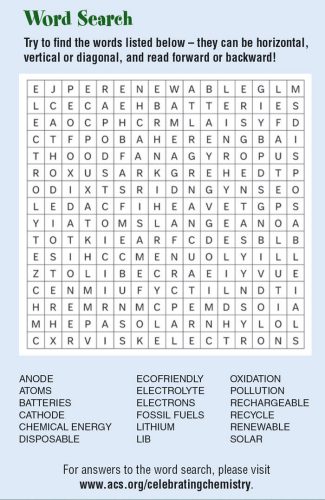
By Sara M. Delgado Rivera
You may have seen homes with pathway or garden lights that turn on at night. Did you know these lights are powered by solar energy? But how do they work at night, when the sun isn’t around to shine on them? The answer is rechargeable batteries (like the ones in cell phones and tablets). These can be charged and used many times over!
Energy coming from the sun is converted into usable electrical energy by solar panels. Batteries store this energy, which can then light up a house’s pathways even when the sun is nowhere to be seen.
Batteries allow us to store and use ecofriendly sources of energy (such as solar and wind energy), where and when we need them. Cars and even houses can run on the sun’s energy by using such batteries. Unlike fossil fuels, we will never run out of renewable sources of energy. The sun, wind, and moving water are examples of renewable energy sources.
There are several types of rechargeable batteries. The most popular is the lithium-ion battery (LIB). They are popular because they can store large amounts of electricity in small sizes. They can also be charged quickly, and are lightweight and easy to maintain! But where does Li come from?
Li is found in Li-rich salt lakes in the Andes mountain range in South America. It is also found in Li-rich rocks in Australia. Recently, on the border between Oregon and Nevada in the U.S., a large deposit of Li was discovered. This is currently the largest known deposit in the world.
What are the challenges?
Li by itself isn’t stable, and is dangerous to handle. A lot of processing is required to separate Li from its natural sources. This includes mining, drilling, evaporation, filtration, purification, and more.
All the processes for Li separation require large amounts of energy and millions of gallons of water. These processes also pollute the air, water, and soil around the mining area. This pollution can cause harm to (or loss of) plant and animal life. It also affects local communities and peoples’ lives by causing serious health issues. Strict environmental laws are needed to protect our environment and people from the hazards of mining Li (and other types of resources).
Li is a nonrenewable resource, just like fossil fuels. Currently, most rechargeable batteries depend on Li in order to work. But it’s not good to depend on any resource that has a limited supply. Because of this, scientists are looking for other battery solutions that don’t rely on Li. Scientists and researchers are also trying to find processes for mining Li that pollute the environment less.
Batteries are currently the biggest hope for changing our dependence on fossil fuels. Recycling Li-based batteries properly can lower the need for mining new Li. Let’s be mindful of the challenges that come with batteries, and plan for a more practical, safer, and greener tomorrow!
The Healing Power of Chemistry Word Search

Sara M. Delgado Rivera is a Chemistry Professor at the University of Puerto Rico at Rio Piedras.

